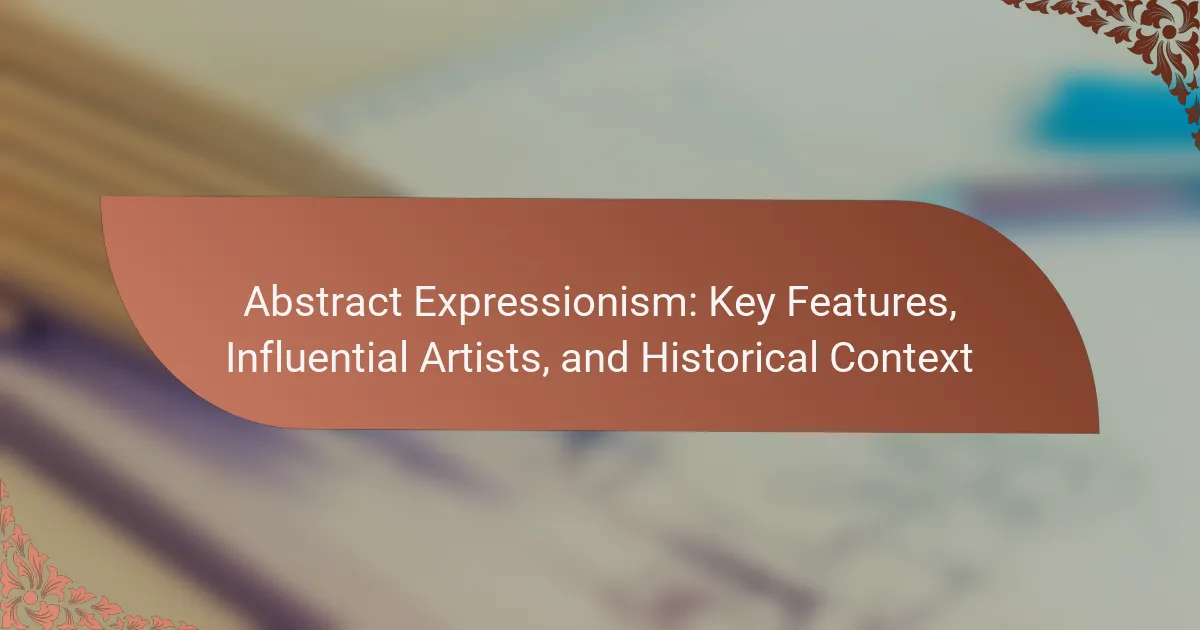Abstract Expressionism revolutionised the art world with its emphasis on spontaneity and emotional intensity. This article explores key features of the movement, influential artists like Jackson Pollock and Mark Rothko, and the historical context that shaped its emergence. It also addresses cultural interpretations and common misconceptions, while highlighting current trends in the appreciation of Abstract Expressionism.
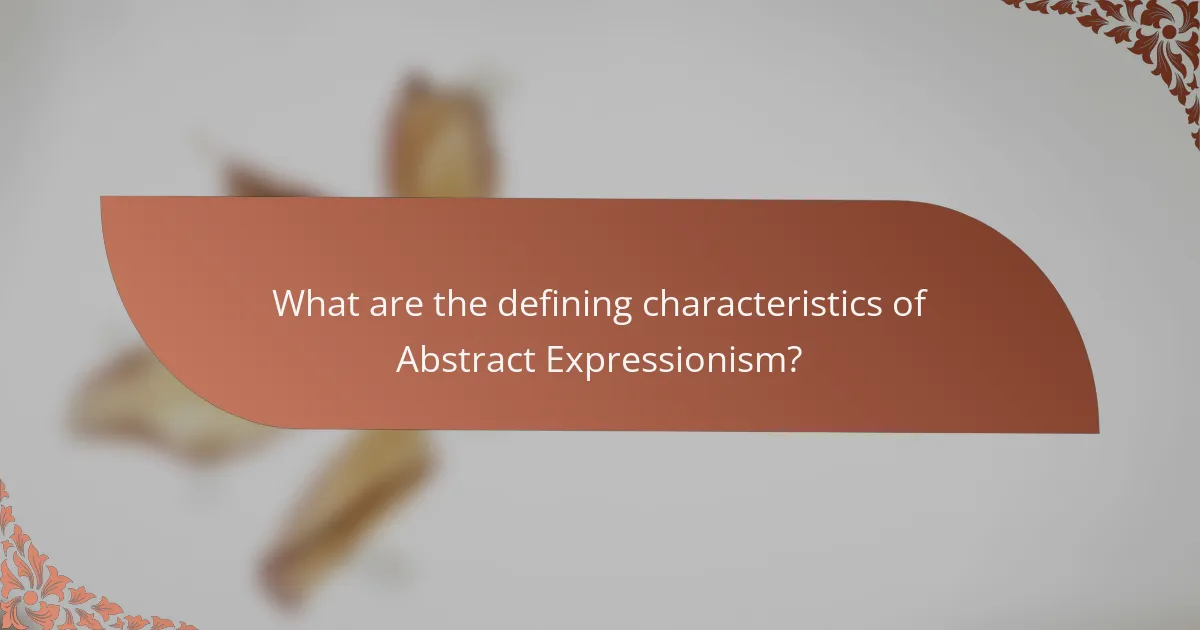
What are the defining characteristics of Abstract Expressionism?
Abstract Expressionism is characterised by spontaneity, emotional intensity, and a focus on the act of painting itself. Key features include large canvases, abstract forms, and vibrant colours. Influential artists like Jackson Pollock and Mark Rothko emphasised individual expression and the subconscious. This movement emerged in the 1940s and 1950s as a response to the trauma of World War II, reflecting a break from traditional artistic conventions.
How does colour play a role in Abstract Expressionism?
Colour is fundamental in Abstract Expressionism, conveying emotion and meaning beyond representation. Artists like Mark Rothko used colour to evoke feelings, with bold, non-representational palettes that engaged viewers on a visceral level. The unique attribute of colour in this movement lies in its ability to create immersive experiences, transforming the viewer’s perception and emotional response. As a result, colour becomes a primary tool for expressing the artist’s inner landscape, making it a central element in understanding Abstract Expressionism.
What techniques are commonly used by Abstract Expressionist artists?
Abstract Expressionist artists commonly use techniques such as gestural brushwork, colour field painting, and spontaneous application of paint. These methods emphasise emotional expression and the physical act of painting. Artists like Jackson Pollock employed drip techniques, while Mark Rothko focused on large blocks of colour to evoke mood. The movement values individuality and experimentation, leading to unique artistic expressions.
Which mediums are favoured in Abstract Expressionism?
Abstract Expressionism primarily favours oil paint, acrylics, and mixed media on canvas. These mediums allow for spontaneous expression and dynamic texture. Artists often use large-scale formats to enhance emotional impact. Techniques like dripping and pouring further define the style, showcasing individual creativity and movement.
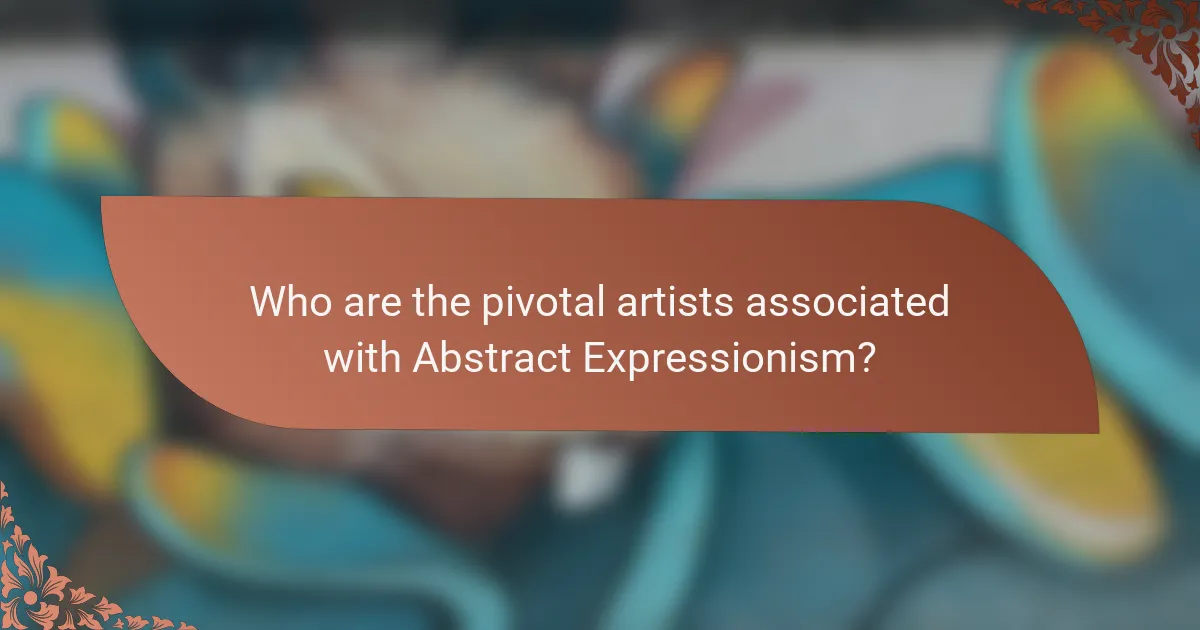
Who are the pivotal artists associated with Abstract Expressionism?
Pivotal artists associated with Abstract Expressionism include Jackson Pollock, Mark Rothko, Willem de Kooning, and Franz Kline. These artists significantly influenced the movement through their innovative techniques and emotional depth. Jackson Pollock is renowned for his drip painting technique, which emphasises spontaneity and movement. Mark Rothko is celebrated for his colour field paintings that evoke deep emotional responses. Willem de Kooning merged abstraction with figuration, creating dynamic compositions. Franz Kline is known for his bold black and white works that explore the interplay of form and space.
What contributions did Jackson Pollock make to the movement?
Jackson Pollock significantly shaped Abstract Expressionism through his innovative drip painting technique. This method emphasised spontaneity and the physical act of painting, allowing emotions to flow freely onto the canvas. Pollock’s work rejected traditional composition, focusing instead on the process and energy of creation. His unique style influenced countless artists, reinforcing the movement’s core values of individual expression and emotional depth.
How did Mark Rothko influence the emotional depth of Abstract Expressionism?
Mark Rothko profoundly influenced Abstract Expressionism by emphasising emotional depth through colour and form. His use of large, luminous canvases created immersive experiences that encouraged introspection. Rothko’s unique attribute was his ability to evoke intense feelings, transforming colour into a vehicle for emotional expression. His works often featured simple geometric shapes, allowing viewers to connect with their own emotions. This focus on emotion over representation was a hallmark of Abstract Expressionism, shaping the movement’s legacy and inspiring countless artists to explore the emotional potential of art.
Which lesser-known artists shaped the Abstract Expressionist landscape?
Several lesser-known artists significantly influenced Abstract Expressionism, including Arshile Gorky, who blended surrealism with abstraction, and Joan Mitchell, recognised for her vibrant, gestural paintings. Other notable figures include Helen Frankenthaler, known for her innovative use of colour field painting, and Sam Francis, whose work incorporated elements of Japanese aesthetics. These artists contributed unique perspectives and techniques that enriched the movement’s landscape.
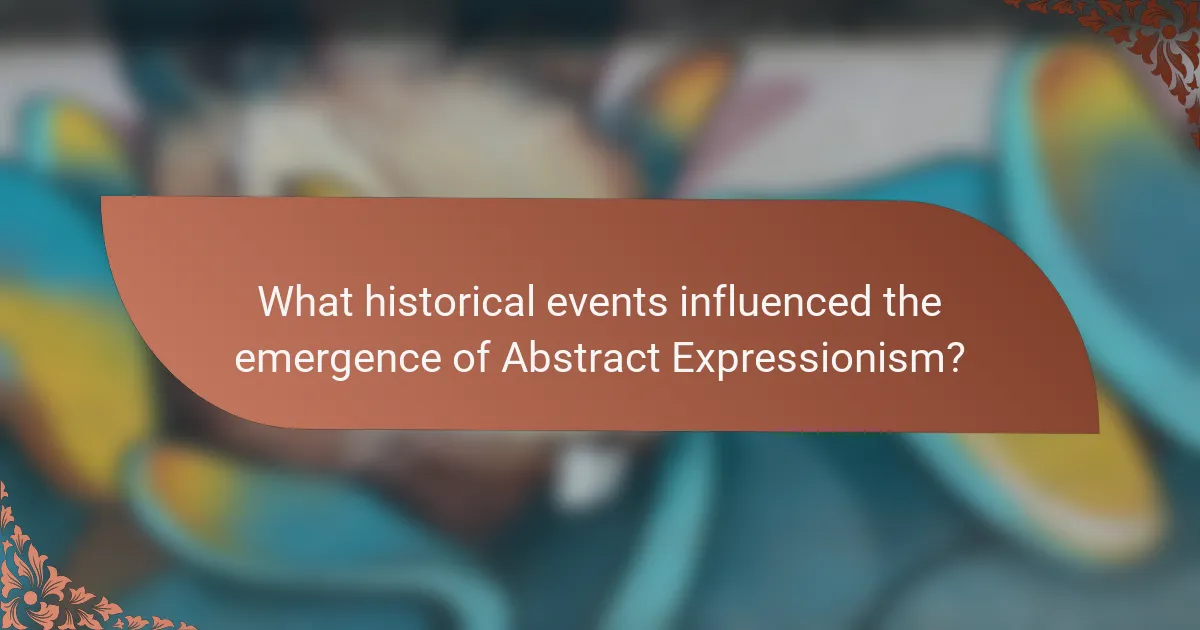
What historical events influenced the emergence of Abstract Expressionism?
The emergence of Abstract Expressionism was influenced by World War II, the Great Depression, and the rise of European modernism. These events shaped artists’ responses to trauma, politics, and the search for identity. The movement emphasised individual expression and spontaneity, reflecting the chaotic socio-political landscape. Key figures like Jackson Pollock and Mark Rothko embodied these ideals, using innovative techniques to convey emotion and depth. The movement’s roots in earlier artistic movements, such as Surrealism and Dada, further contributed to its development, allowing artists to experiment with form and content.
How did World War II impact the art world and Abstract Expressionism?
World War II significantly influenced the art world, leading to the emergence of Abstract Expressionism. The chaos and trauma of the war prompted artists to explore deep emotional expression and individuality. This movement emphasised spontaneity and the subconscious, breaking away from traditional forms. Key figures, such as Jackson Pollock and Mark Rothko, used bold colours and dynamic techniques to convey their experiences. The post-war context fostered a sense of freedom, encouraging artists to challenge conventions and embrace new forms of creativity.
What role did New York City play in the development of Abstract Expressionism?
New York City was pivotal in the development of Abstract Expressionism by fostering a vibrant art scene. The city became a hub for artists in the mid-20th century, facilitating collaboration and innovation. Influential artists like Jackson Pollock and Mark Rothko thrived in this environment, pushing boundaries through their work. The New York School, a collective of these artists, emerged, emphasising individual expression and emotional intensity, which defined the movement. As a result, New York City transformed into the epicentre of modern art, influencing generations to come.
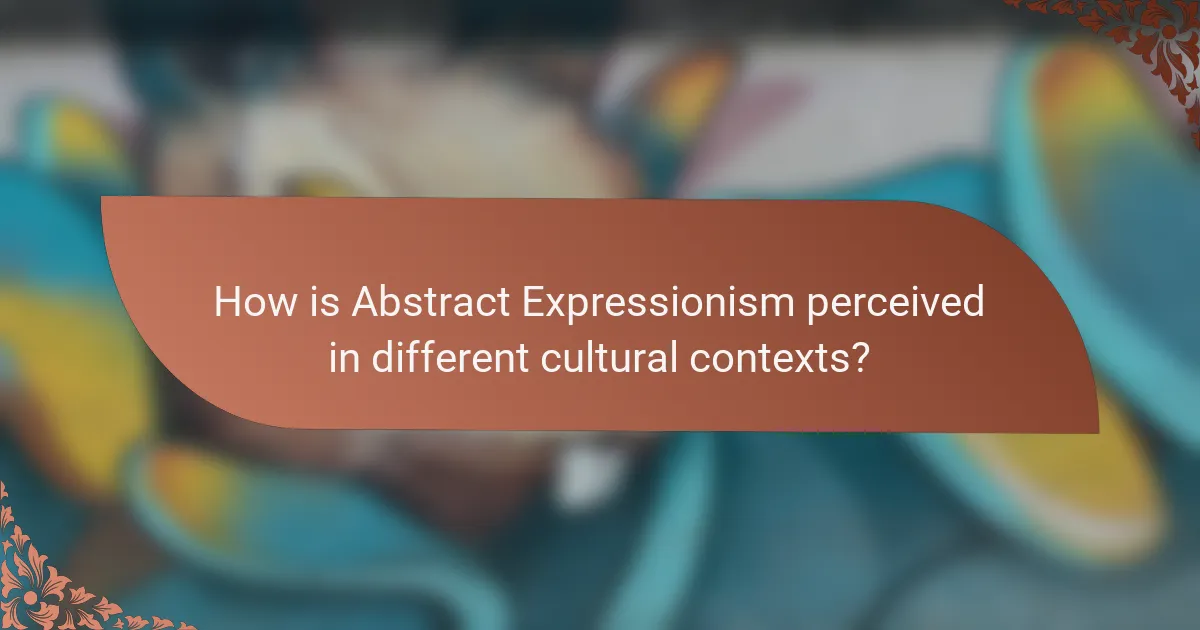
How is Abstract Expressionism perceived in different cultural contexts?
Abstract Expressionism is perceived differently across cultural contexts, reflecting unique historical and social influences. In Western cultures, it often symbolises individualism and emotional expression, while in Eastern contexts, it may emphasise collective experience and harmony. This divergence highlights how cultural backgrounds shape the interpretation of artistic movements. For instance, in Japan, Abstract Expressionism can be seen as a fusion with traditional aesthetics, leading to a unique synthesis. In contrast, in Latin America, it is often linked to political expression and social commentary. These variations illustrate the rich tapestry of meaning that Abstract Expressionism holds globally.
What are the contemporary interpretations of Abstract Expressionism in Canada?
Contemporary interpretations of Abstract Expressionism in Canada emphasise emotional expression and individuality. Artists draw from historical influences while incorporating modern themes and techniques.
Canadian artists like Jack Bush and Jean-Paul Riopelle expanded the movement by integrating local landscapes and cultural narratives. Their works reflect a unique blend of spontaneity and structure, showcasing the evolution of Abstract Expressionism in a Canadian context.
Current exhibitions often highlight diverse perspectives, focusing on inclusivity and the impact of social issues. This approach resonates with contemporary audiences, fostering a deeper connection to the art form.
Overall, contemporary Canadian interpretations of Abstract Expressionism continue to evolve, maintaining the movement’s core principles while adapting to modern sensibilities.
How do British artists respond to the themes of Abstract Expressionism?
British artists respond to Abstract Expressionism by incorporating emotional intensity and spontaneity in their work. They often explore personal narratives and cultural identity through abstraction. Key figures like Francis Bacon and David Hockney reinterpret these themes, blending them with unique British sensibilities. Bacon’s distorted figures convey existential angst, while Hockney’s vibrant colours reflect optimism and lightness. This adaptation showcases how British artists uniquely engage with the movement’s core principles while addressing their own cultural contexts.
What is the reception of Abstract Expressionism in Russia today?
The reception of Abstract Expressionism in Russia today is mixed, with both admiration and criticism. Some contemporary artists embrace its emotional intensity and spontaneity, while others argue it lacks the cultural depth found in Russian art traditions. Notably, exhibitions showcasing Abstract Expressionism have gained popularity, reflecting a growing interest in Western art movements. However, debates continue regarding its relevance and authenticity within the Russian context.
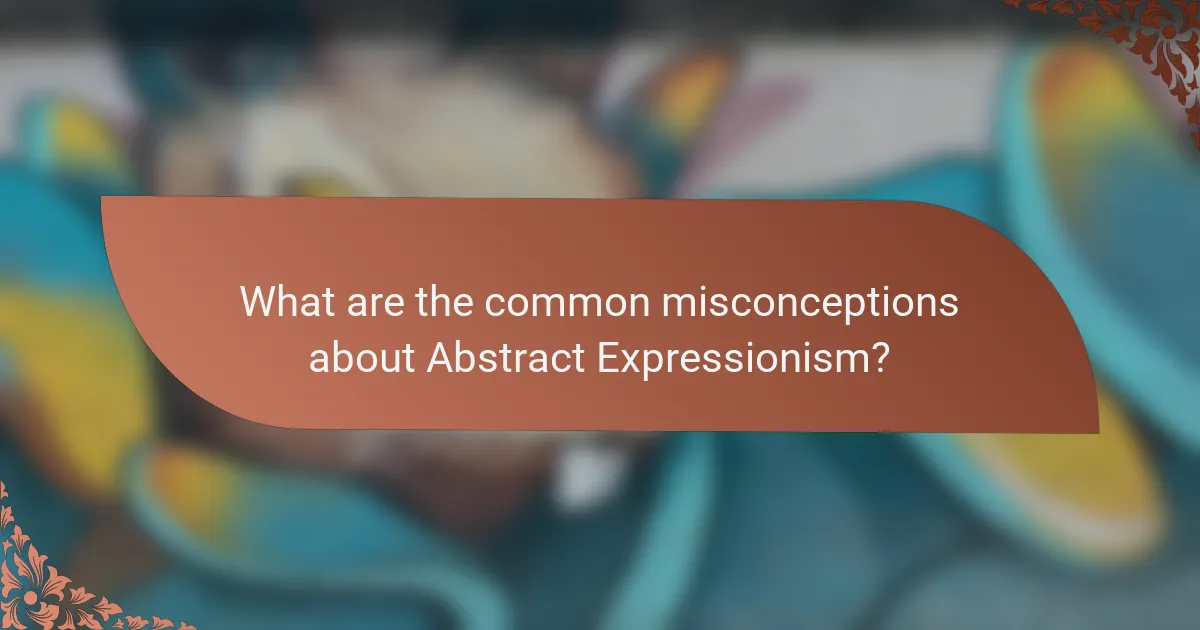
What are the common misconceptions about Abstract Expressionism?
Many misconceptions about Abstract Expressionism persist, often oversimplifying its complexity. One common belief is that it lacks form or structure, while in reality, artists employed specific techniques and intentions. Another misconception is that the movement is entirely spontaneous; however, many works involved meticulous planning and layering. Some people think Abstract Expressionism is solely about emotional expression, neglecting its connections to political and social contexts. Additionally, the idea that all Abstract Expressionist works are non-representational overlooks the subtle influences of figuration in many pieces.
Why is Abstract Expressionism often misunderstood as chaotic or random?
Abstract Expressionism is often misunderstood as chaotic or random due to its emphasis on spontaneity and emotion. Critics often overlook the underlying structure and intentionality behind the artworks. Influential artists like Jackson Pollock and Mark Rothko utilised techniques that, while appearing haphazard, were rooted in deep personal expression and philosophical concepts. The historical context of post-World War II America also contributed to this perception, as artists sought to break away from traditional forms and explore new modes of visual communication.
How do critics differentiate between Abstract Expressionism and other modern art movements?
Critics differentiate Abstract Expressionism by its emphasis on spontaneous, automatic, or subconscious creation, contrasting it with structured movements like Cubism. Key features include large canvases, vibrant colours, and expressive brushwork. Influential artists like Jackson Pollock and Mark Rothko exemplify these traits, focusing on emotional experience over representational accuracy. Historical context reveals a reaction to World War II, reflecting chaos and individualism in art.
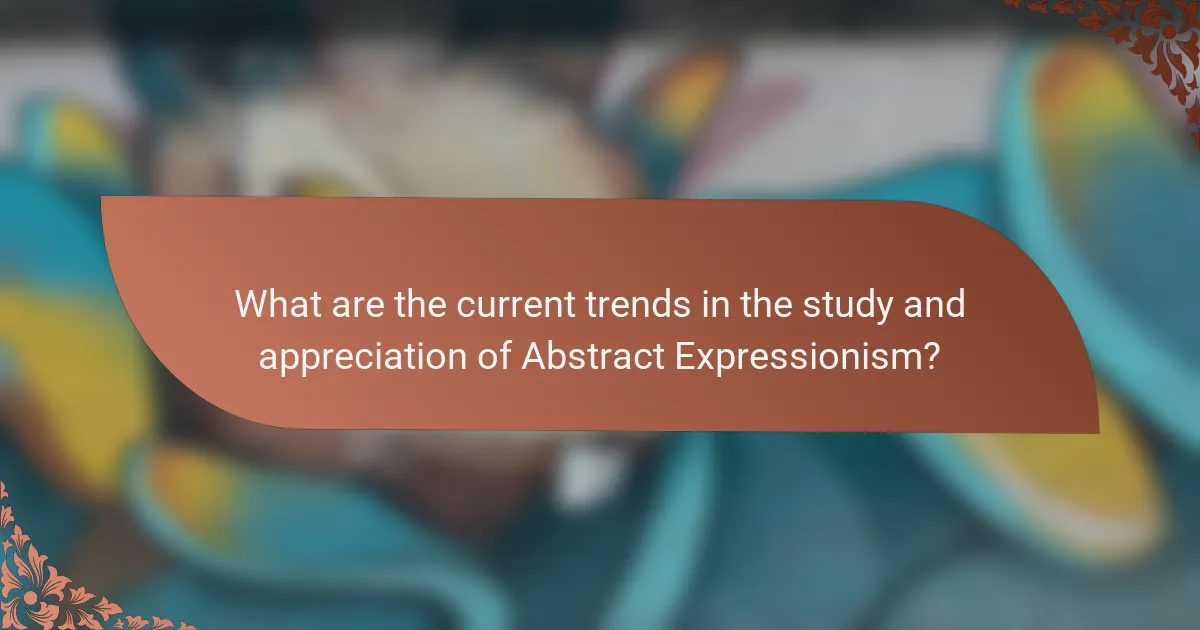
What are the current trends in the study and appreciation of Abstract Expressionism?
Current trends in the study and appreciation of Abstract Expressionism emphasise a renewed interest in its social and political contexts. Scholars explore how the movement reflects post-war American identity and the psychological dimensions of its artists. Contemporary exhibitions increasingly feature diverse interpretations, highlighting underrepresented voices and global influences. Additionally, digital platforms facilitate broader access to artworks and discussions, enhancing public engagement and appreciation. This evolution marks a shift from traditional narratives to more inclusive perspectives on Abstract Expressionism’s impact and relevance today.
How are digital platforms influencing the visibility of Abstract Expressionist works?
Digital platforms significantly enhance the visibility of Abstract Expressionist works by broadening their audience reach and accessibility. Social media, online galleries, and virtual exhibitions allow artists and institutions to showcase these artworks to global audiences. This increased exposure fosters engagement and dialogue around Abstract Expressionism, highlighting its emotional intensity and spontaneity. Furthermore, digital platforms enable the preservation and dissemination of historical context, making it easier for new generations to explore the movement’s key features and influential artists.
What role do museums and galleries play in preserving Abstract Expressionism?
Museums and galleries play a crucial role in preserving Abstract Expressionism by safeguarding its artworks and promoting public understanding. They provide a platform for education, allowing visitors to engage with the movement’s history and significance. Through exhibitions, they showcase influential artists like Jackson Pollock and Mark Rothko, highlighting their unique contributions. Additionally, museums conduct research and conservation efforts to maintain the integrity of these artworks, ensuring their legacy for future generations. By curating collections and hosting events, they foster appreciation and dialogue around this pivotal art movement.
What best practices can art enthusiasts follow when exploring Abstract Expressionism?
Art enthusiasts should immerse themselves in the emotional impact of Abstract Expressionism. Engage with artworks by examining colour, form, and texture. Attend exhibitions to experience the scale and context of pieces. Study influential artists like Jackson Pollock and Mark Rothko to understand their techniques. Reflect on personal interpretations to deepen appreciation.
